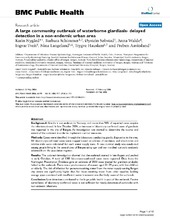A large community outbreak of waterborne giardiasis- delayed detection in a non-endemic urban area
Nygård, Karin; Schimmer, Barbara; Søbstad, Øystein; Walde, Anna; Tveit, Ingvar; Langeland, Nina; Hausken, Trygve; Aavitsland, Preben
Peer reviewed, Journal article
Permanent lenke
https://hdl.handle.net/1956/1916Utgivelsesdato
2006-05-25Metadata
Vis full innførselSamlinger
Originalversjon
https://doi.org/10.1186/1471-2458-6-141Sammendrag
Background: Giardia is not endemic in Norway, and more than 90% of reported cases acquire the infection abroad. In late October 2004, an increase in laboratory confirmed cases of giardiasis was reported in the city of Bergen. An investigation was started to determine the source and extent of the outbreak in order to implement control measures. Methods: Cases were identified through the laboratory conducting giardia diagnostics in the area. All laboratory-confirmed cases were mapped based on address of residence, and attack rates and relative risks were calculated for each water supply zone. A case control study was conducted among people living in the central area of Bergen using age- and sex matched controls randomly selected from the population register. Results: The outbreak investigation showed that the outbreak started in late August and peaked in early October. A total of 1300 laboratory-confirmed cases were reported. Data from the Norwegian Prescription Database gave an estimate of 2500 cases treated for giardiasis probably linked to the outbreak. There was a predominance of women aged 20–29 years, with few children or elderly. The risk of infection for persons receiving water from the water supply serving Bergen city centre was significantly higher than for those receiving water from other supplies. Leaking sewage pipes combined with insufficient water treatment was the likely cause of the outbreak. Conclusion: Late detection contributed to the large public health impact of this outbreak. Passive surveillance of laboratory-confirmed cases is not sufficient for timely detection of outbreaks with non-endemic infections.
